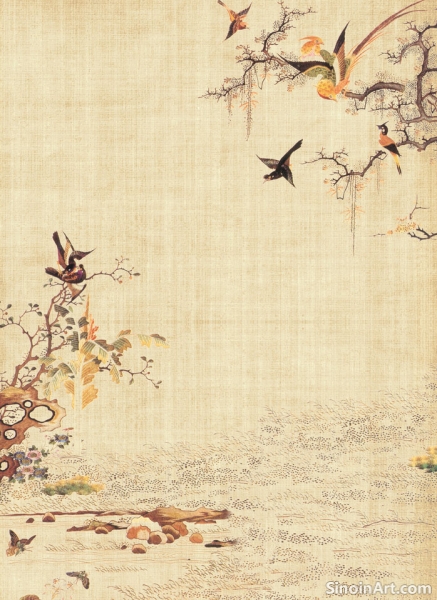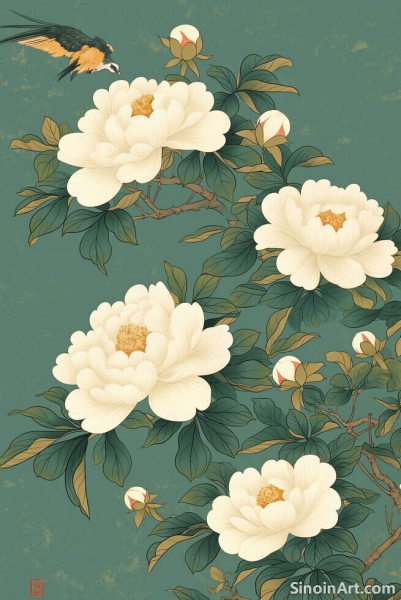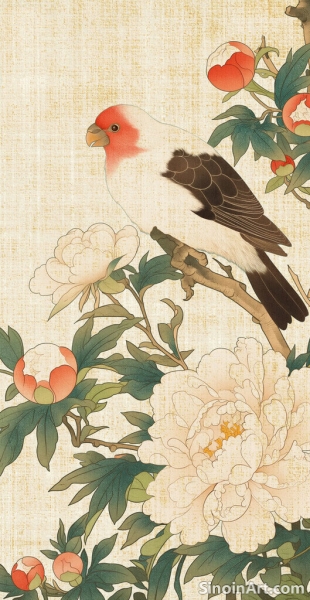Gongbi Painting Throughout History: From Courts to Modern Studios
|
Gongbi painting's long and fascinating history is marked by significant periods of innovation and change. Its origins can be traced back to the Han dynasty (206 BC – 220 AD), where it was used for detailed depictions of religious figures, court scenes, and historical events. Over the centuries, the style continued to evolve, becoming a highly refined form of artistic expression.  During the Tang dynasty (618 – 907 AD), Gongbi painting reached new heights of sophistication, with renowned artists creating exquisite works that showcased both technical mastery and aesthetic elegance. The style was highly favored by the imperial court, and its use spread to other elite circles, with its primary focus still on portraiture and courtly scenes. This period was considered a golden age for many art forms in China, not just Gongbi.  The Song dynasty (960 – 1279 AD) witnessed a shift in focus toward more nature-based themes, with birds, flowers, and landscapes becoming increasingly popular subjects. Artists began to explore the subtle variations in color and texture, further refining the techniques of Gongbi painting. The precision and detail of this period are what many consider the pinnacle of the style.  The Ming (1368 – 1644) and Qing (1644 – 1912) dynasties saw a continuation of these traditions, with the style remaining a respected and admired form of artistic expression. During this time, there were notable changes in subject matter and color palette, reflecting shifts in artistic tastes and societal values. However, the essence of meticulous brushwork remained a core element. Today, Gongbi painting continues to be practiced and celebrated. While still adhering to traditional techniques, contemporary artists are also exploring new directions, blending classic methods with modern sensibilities. These artists are finding new ways to express themselves within the parameters of the style, ensuring its continued relevance and vitality in the 21st century. Gongbi's journey from royal courts to modern studios demonstrates its enduring appeal and adaptability. |
Tag : History of Gongbi painting, Tang Dynasty art, Song Dynasty painting, Chinese imperial art, modern Gongbi artists
Related information
- The Symbolism of Gongbi: Decoding the Language of the Brush
- The Use of White Space in Gongbi Composition
- Gongbi Painting and the Influence of Chinese Poetry
- Gongbi Painting and the Four Gentlemen: Symbolism in Nature
- The Challenge of Large-Scale Gongbi Painting
This article explores the symbolic elements found in Gongbi paintings, focusing on the meanings behind flowers, animals, colors, and compositions within the Chinese artistic tradition.
This article explores the importance of white space in Gongbi composition, highlighting its role in defining the main subject, creating depth, contributing to overall balance, and reflecting the philosophical principles of emptiness and the interplay of yin and yang.
This article explores the influence of Chinese poetry on Gongbi painting, highlighting the shared themes, imagery, and symbolic language, and how this connection enhances the literary and artistic impact of the artwork.
Explores the symbolism of the Four Gentlemen (plum blossom, orchid, bamboo, chrysanthemum) in Gongbi painting, highlighting their cultural significance and representation.
This article explores the unique challenges of creating large-scale Gongbi paintings, including maintaining precision, acquiring specialized materials, managing composition, and the time-consuming process of layering colors and details.